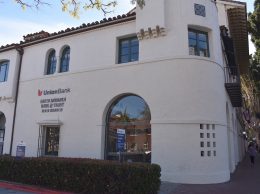Recession, mergers and the future of finance
IN THIS ARTICLE
- Banking & Finance Topic
- Stephen Nellis Author
By Stephen Nellis Friday, March 16th, 2012
EDITOR’S NOTE: This is one part in a three-part package on Union Bank’s acquisition of Pacific Capital Bancorp, the parent of Santa Barbara Bank & Trust. Read the other two stories here:
- “Union deal rattles region’s banks.” A look at the key players in the banking landscape as the largest independent bank in the Tri-Counties prepares to exit the scene.
- “End of an era for SBB&T brand.” A look back at the 52-year history of a company that enjoyed exceptional customer and shareholder loyalty.
First there were three, then two, then one. And now, none.
Pacific Capital Bancorp, parent of Santa Barbara Bank & Trust, was the last large independent banking firm in the Tri-Counties. Its nearest competitor, First California Financial Group, is a third the size of the market leader now being bought by Union Bank for $1.5 billion.
Pacific Capital was first a beneficiary, and is now a casualty, of a consolidation trend in banking that experts say shows no sign of slowing. And some observers believe that could mean an increasing “doughnut hole” of customers — expanding small businesses that need more cash than they can scrape together from friends and family and yet can’t get financing at bigger banks — will fall in the ever-growing gap.
“Big banks continue to acquire smaller banks, and new banks are started every year. But the net trend is downward,” Marshall Milligan, who was president of one of the Tri-County titans, Ventura County’s Bank of A. Levy, when it sold to First Interstate Bank in 1994 for $86.5 million, said in an email. “Even more important, because of the consolidation at the top of the industry, there are fewer buyers every year. So the opportunity to make money by starting and building a local bank and then selling it to a large bank is becoming less reliable.”
Carroll Pruett agrees. He was CEO of Pacific Capital’s strongest counterpart, Mid-State Bank & Trust, from 1967 to 2000 and set the stage for its $857 million sale to Rabobank in 2007.
“The outlook for community banking, in my opinion after 50 years in community banking, is rather difficult,” Pruett told the Business Times. “The regulatory environment has gotten more difficult. The opportunity for any spread on your loans and deposits and other services is limited. It’s certainly not as enticing as it was a few years ago.”
Nationally, assets are steadily marching into fewer and fewer hands. In 1985, there were 14,884 banks in the United States, and there were 7,842 in 2003, according to the Federal Deposit Insurance Corp.’s banking review. Moreover, where banks with more than $100 million in assets once made up less than a third of the nation’s institutions, they now make up more than half.
Pacific Capital itself played a role, snapping up more than a half-dozen institutions starting in the late 1990s.
The financial crisis of 2008 quickened the pace of consolidation through failures and the semi-failures of arranged marriages. In the Tri-Counties alone, three banks — Affinity Bank, Los Padres Bank and San Luis Trust Bank — have failed since 2007.
“What we’re seeing is change,” said Rod Brown, president of the California Bankers Association. “The acquirers of Mid-State and Pacific Capital are two very fine banks that are a very important part of the fabric of the banking community. I think if change was inevitable, we’re fortunate that Union Bank will become a more significant banking presence on the Central Coast,” said Brown, who calls Santa Barbara home.
Brown said that there are efforts afoot to create a special class for community banks that would ease some of the regulatory burdens that currently make it more profitable to be larger.
Bill Watkins, a California Lutheran University economist, said stiffer rules require banks to have more scale to spread the cost of compliance. “There’s been a decreasing ability of small banks over time to do what they do — to help small businesses,” Watkins said. “What increases the systemic risks is a concentration of assets in banks that are too big to fail.”
But “too big to fail” really doesn’t extend to banks that stick to fairly traditional business models but do so at a bigger scale, said Julianna Balicka, an analyst with Keefe, Bruyette & Woods who follows First California Financial Group in Westlake Village and has followed Pacific Capital in the past. “Too big to fail and just being a larger retail bank are two different things,” she said. “The cleaner the bank’s business model, the safer an investment it is.
The larger the bank’s growth, the better its risk management gets. You develop into a stronger bank.”
On the other hand, banks such as Pacific Capital, Mid-State and Bank of A. Levy offered something unique — the capital muscle to offer big credit, and the local control to take a risk on what in rosier times was known as a “character loan.” Promising customers who don’t make numbers in a computer model get left out at bigger banks, said Pruett.
“The local contractor, the local retailer who’s just a Main Streeter, particularly in the smaller communities. Somebody who doesn’t need millions of dollars in lines, but a few hundred thousand dollars,” Pruett said. “That’s what Santa Barbara Bank & Trust was getting back into. They were coming back to being a super community bank.”
Sung Won Sohn, a CSU Channel Islands economist who was formerly chief economist for Wells Fargo, said larger banks present advantages for expanding businesses. Consolidation has its benefits, he said.
“They are able to take care of everybody from small grocery stores to large multinational corporations,” Sohn said. “When some smaller companies are acquired by larger banks, you have a lot more options. If the Santa Barbara Bank & Trust branches need more capital, they can certainly get it now from the parent company.”
Related Articles
 Monday, July 25th, 2022
Monday, July 25th, 2022











